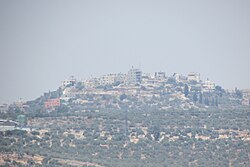Type a search term to find related articles by LIMS subject matter experts gathered from the most trusted and dynamic collaboration tools in the laboratory informatics industry.
Far'ata | |
|---|---|
| Arabic transcription(s) | |
| • Arabic | فرعتا |
| • Latin | Far'ata (unofficial) |
 Far'ata | |
Location of Fara'ata within Palestine | |
| Coordinates: 32°11′26″N 35°09′57″E / 32.19056°N 35.16583°E | |
| Palestine grid | 165/177 |
| State | State of Palestine |
| Governorate | Qalqilya |
| Government | |
| • Type | Local Development Committee |
| Elevation | 432−518 m (−1,267 ft) |
| Population (2017)[2] | |
• Total | 872 |
| Name meaning | Ferata, p.n.[3] |
Far'ata (Arabic: فرعتا) was a Palestinian village in the Qalqilya Governorate in the Western area of the West Bank, located 16 kilometers Southwest of Nablus. According to the Palestinian Central Bureau of Statistics, the village had a population of 872 inhabitants in 2017.[2]
In 2012 Fara'ata was merged with the larger Immatain village council.[1]
Immatin and Far’ata are located 19 kilometers (12 mi) west of Qalqiliya. They are bordered by Tell to the east, Deir Istiya to the south, Jinsafut, Al Funduq and Hajjah to the west, and Kafr Qaddum and Jit to the north.[1]
Byzantine ceramics have been found in the village.[4]
Fara'ata was noted in the Samaritan Chronicle (from the 12th century) under the name of Ophrah, while it has been known under its present name since the 14th century.[5]
Far'ata was incorporated into the Ottoman Empire in 1517 with all of Palestine, and in 1596 it appeared in the tax registers as Fara'ta, being in the Nahiya of Jabal Qubal of the Liwa of Nablus. It had a population of 12 households and 6 bachelor, all Muslim. The villagers paid a fixed tax rate of 33,3% on a number of crops, including wheat, barley, summer crops, olive trees, goats and beehives, in addition to occasional revenues, a press for olive oil or grape syrup, and a fixed tax for people of Nablus area; a total of 4,500 Akçe.[6]
In 1838, Fer'ata was noted as located in Jurat Merda, south of Nablus.[7]
In 1870 the French explorer Victor Guérin visited Far'ata, which he described having "a very small number" of people, with some cisterns and remains of a stone sarcophagus as remnants of former history.[8]
In 1870/1871 (1288 AH), an Ottoman census listed the village with a population of 10 households in the nahiya (sub-district) of Jamma'in al-Awwal, subordinate to Nablus.[9]
In the PEF's Survey of Western Palestine (SWP) (1882), Far'ata was described as a "small village of ancient appearance, standing on a [..] mound, with a rock-cut tomb to the south, and a sacred Mukam to the east."[5]
In the 1922 census of Palestine conducted by the British Mandate authorities, Far'ata had a population of 36, all Muslim,[10] increasing in the 1931 census to of 47 Muslims, in a total of 11 houses.[11]
In the 1945 statistics the population of Far'ata was 70 Muslims,[12] while the total land area was 1,664 dunams, according to an official land and population survey.[13] Of this, 56 were allocated for plantations and irrigable land, 961 for cereals,[14] while 10 dunams were classified as built-up areas.[15]

In the wake of the 1948 Arab–Israeli War, and after the 1949 Armistice Agreements, Far'ata came under Jordanian rule.
The Jordanian census of 1961 found 317 inhabitants in Faraata.[16]
Since the Six-Day War in 1967, Far'ata has been held under Israeli occupation.
After the 1995 accords, 58.3% of the total village land of Immatain/Far'ata was assigned as Area B land, while the remaining 41.7% is Area C land.[17]
In 2010, Far'ata was described by Gideon Levy as one of the Palestinian villages where the people "live in terror of the settlers and their accursed 'Price tag,' and nobody came to their defense".[18]
Fara'ata's residents originally came from Immatain.[19]